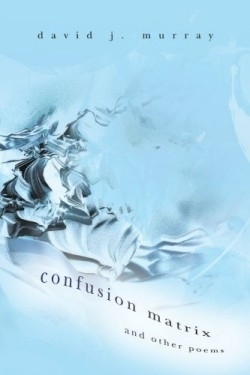Confusion Matrix
In Confusion Matrix, readers are transported through the age of the Classical and Romantic poets to our own time and place. While the themes are timeless and the poet accesses them through modern experiences, there are a number of qualities that evoke this vintage feel.
David J. Murray is clearly rooted in the Classical and Romantic traditions. There are many references to the literature of these poetic times. In number 14, for example, he references Atlas and Anacreon; in number 18, he speaks of “lingering Laocoönic mastery.” Murray is clearly deeply literate, with knowledge of classical art in multiple forms. His literary references include Beatrice, the Titans, and the Aeneid. He includes here a short series of poems based on various pieces by Bach, Schubert, and Wagner that reveal his appreciation of classical music. This education also infuses poems that are based on his profession of psychology.
Murray’s language structures and word choices also evoke the Classical and Romantic traditions. “O Thou,” a love poem constructed from this older word, ends in the beauty of “O,” the O of wonder, the circling O, the O of completeness. Many words include the archaic accent grave: wreakèd, collapsèd, glossy-eyèd. There are words such as “unteazl’d,” “o’er,” and “atwixt,” and phrases like “mordant remnants,” “th’unpenetrated world,” and “Of thou and you diluted to a Thee.”
The poems’ language flows beautifully in this setting. It is easy to sink into this world and just let the sounds and rhythms flow. There’s a timeless sense of continuity about this work, something that transports from simple meaning to total experience.
The poet introduces certain poems with an explanation. His introduction to the long poem, “Confusion Matrix,” is critical to an understanding of its content. In this case “confusion matrix” is not just about confusion; it is a specific table that shows how often a person, while listening, confuses one sound with another. Based on that, the poet explores the range and world of emotions, confusion, and misunderstandings. Each piece (there are twenty-five) then fits into that matrix and informs the other pieces as they unfold.
The shorter sets of poems were written over many years. They seamlessly show how the poet’s mastery has evolved, and yet the quality is even and complete.
Lovers of poetry will revel in this work, enjoying it both as a work from a twenty-first-century poet and as a work that fits into a timeless and unbroken thread of poetry from the classical era to today.
Disclosure: This article is not an endorsement, but a review. The publisher of this book provided free copies of the book and paid a small fee to have their book reviewed by a professional reviewer. Foreword Reviews and Clarion Reviews make no guarantee that the publisher will receive a positive review. Foreword Magazine, Inc. is disclosing this in accordance with the Federal Trade Commission’s 16 CFR, Part 255.

